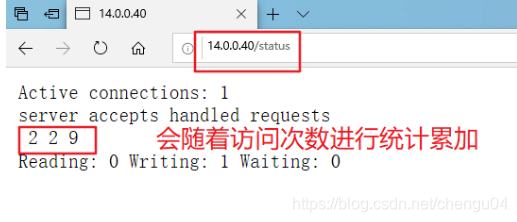文章目录
简介
●一款高性能、轻量级Web服务软件
稳定性高
系统资源消耗低
●对HTTP并发连接的处理能力高(能够处理高并发)
单台物理服务器可支持30000~50000个并发请求
一、Nginx主配置文件剖析
1.1全局配置
#user nobody; ##指定用户,默认是匿名用户
worker_processes 1; ##工作进程,实现高并发可以增加值
#error_log logs/error.log; ##错误日志文件
#pid logs/nginx.pid; ##pid文件
1.2I/O事件配置
events { ##一个进程包含多个线程
use epoll; #能显著提高程序在大量并发连接中只有少量活跃的情况下的系统CPU利用率
worker_connections 4096;
}
连接数是4096,基于上面的进程数
1.3http配置
http{}:协议层面;server{}:服务层面;location{}:网页站点目录层面
http {
access_log logs/access.log main;
sendfile on; ##发送邮件
keepalive timeout 65; ##连接超时时间
server {
listen 80;
server_name localhost; ##域名
charset utf-8; ##字符集
location / {
root html; ##网页站点目录名称
index index.html index.php; } ##主页的相对路径
error_page 500 502 503 504 /50x.html; ##提示错误页面(500是服务器出错)
location = /50x.html {
root html; }
}
}
二、Nginx优化服务
2.1Nginx的访问状态统计
1.编译安装nginx(configure的时候需要添加–with-http_stub_status_module)
nginx -V 可以查看已安装的nginx是否包含http_stub_status模块
[root@localhost ~]# vim /usr/local/nginx/conf/nginx.conf ##进入主配置文件配置统计页面,(location /status 虚拟目录),添加如下配置
location /status {
stub_status on; ##统计模块开启
access_log off; ##访问日志关闭
}
2.进入客户端浏览器访问14.0.0.40/status进行验证

2.2Nginx支持的虚拟主机
●基于域名的虚拟主机
●基于IP的虚拟主机
●基于端口的虚拟主机
●通过“server{}”配置段实现
2.2.1基于域名的虚拟主机
www.test.com 14.0.0.40
www.benet.com 14.0.0.40
1.配置两个域名的域名解析
[root@localhost ~]# vim /etc/named.conf
options {
listen-on port 53 { any; };
allow-query { any; };
[root@localhost ~]# vim /etc/named.rfc1912.zones
zone "test.com" IN {
type master;
file "test.com.zone";
allow-update { none; };
};
zone "benet.com" IN {
type master;
file "benet.com.zone";
allow-update { none; };
};
[root@localhost ~]# cd /var/named
[root@localhost named]# cp -p named.localhost test.com.zone
[root@localhost named]# vim test.com.zone
...省略内容
NS @
A 127.0.0.1
www IN A 14.0.0.40
[root@localhost named]# cp -p test.com.zone benet.com.zone
[root@localhost named]# systemctl start named
2.进入主配置文件配置虚拟主机(可在配置文件末尾单独插入,注意大括号)
[root@localhost ~]# vim /usr/local/nginx/conf/nginx.conf
server {
server_name www.test.com;
location / {
root /var/www/test;
index test.html;
}
}
server {
server_name www.benet.com;
location / {
root /var/www/benet;
index benet.html;
}
}
[root@localhost www]# pkill nginx
[root@localhost www]# nginx
3.用客户端的浏览器访问www.test.com和www.benet.com进行验证

2.2.2基于端口的虚拟主机
注意:访问网站前,先清空浏览器缓存
www.test.com 14.0.0.40:8080
www.benet.com 14.0.0.40:8888
1.修改主配置文件
[root@localhost www]# vim /usr/local/nginx/conf/nginx.conf
server {
listen 14.0.0.40:8080;
server_name 14.0.0.40:8080;
location / {
root /var/www/test;
index test.html;
}
}
server {
listen 14.0.0.40:8888;
server_name 14.0.0.40:8888;
location / {
root /var/www/benet;
index benet.html;
}
}
2.访问14.0.0.40:8080,14.0.0.40:8888进行验证

2.2.3基于IP的虚拟主机
www.test.com 14.0.0.40
www.benet.com 14.0.0.128
1.主机配置两个IP地址,修改Nginx服务器主配置文件
[root@localhost www]# vim /usr/local/nginx/conf/nginx.conf
server {
listen 14.0.0.40:80;
server_name 14.0.0.40:80;
location / {
root /var/www/test;
index test.html;
}
}
server {
listen 14.0.0.128:80;
server_name 14.0.0.128:80;
location / {
root /var/www/benet;
index benet.html;
}
}
2.访问14.0.0.40,14.0.0.128进行验证

2.3Nginx身份验证访问
1.创建能够访问web网站的用户
[root@localhost benet]# yum -y install httpd
[root@localhost benet]# which htpasswd
/usr/bin/htpasswd
##htpasswd命令需要先安装httpd
[root@localhost ~]# htpasswd -c /usr/local/nginx/passwd.db tom
New password:
Re-type new password:
Adding password for user tom
[root@localhost ~]# ll /usr/local/nginx | grep passwd.db
-rw-r--r--. 1 root root 42 8月 7 17:21 passwd.db
[root@localhost ~]# chown nginx /usr/local/nginx/passwd.db
[root@localhost ~]# chmod 400 /usr/local/nginx/passwd.db
[root@localhost ~]# vim /usr/local/nginx/conf/nginx.conf
...省略内容
location / {
auth_basic "secret";
auth_basic_user_file /usr/local/nginx/passwd.db;
root html;
index index.html index.htm;
}
2.登录网站14.0.0.40进行验证

2.4Nginx基于客户端控制用户访问
deny IP/IP段:拒绝某个IP或IP段的客户端访问
allow IP/IP段:允许某个IP或IP段的客户端访问
规则从上往下执行,如匹配则停止,不再往下匹配
1.进入主配置文件,location / { }配置段中加入黑名单14.0.0.77
[root@localhost ~]# vim /usr/local/nginx/conf/nginx.conf
...省略内容
location / {
deny 14.0.0.77;
allow all;
root html;
index index.html index.htm;
}
...省略内容
2.在IP地址为14.0.0.77的客户端中使用浏览器访问网站,会显示禁止访问
